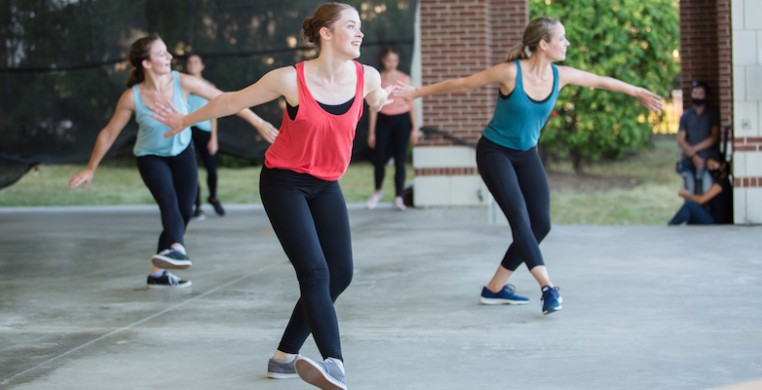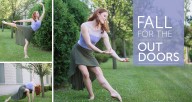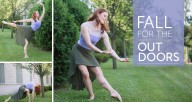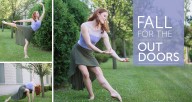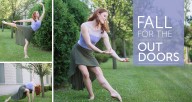Until Saturday, I hadn’t seen a live dance performance for five months and 14 days (not that I’m counting or anything). I would say it’s like riding a bike—in fact, a lot of things about attending Ballet 5:8’s new outdoor dance season were wholly ordinary. But the renewed novelty of live performance, which was so briskly and completely taken away last March, is not lost on me. Settling into an old routine with pen and pad, all I could really feel was an enormous sense of gratitude.
Performing in an open-air pavilion at New Lenox Commons—an idyllic commercial district built in 2005 that anchors the Joliet-adjacent exurb—Ballet 5:8 offered just two pieces in a quick 40-minute performance, danced twice on Saturday evening. Earlier that day, the company premiered “The Rough-Face Girl,” also done twice. The trio of works are part of an outdoor dance series made with coronavirus restrictions in mind, which will tour Chicagoland for the next four weeks.
That sounds awful for any dancer on a typical summer day in Illinois. But on this occasion, the weather was about as good as it gets: a gentle breeze, mild temperatures and a gorgeous evening glow, which cast a natural lighting design on the company’s final performance at 6 p.m. And since the dancers of Ballet 5:8 also hadn’t seen a stage since March, it’s safe to say everyone in that park was feeling happiness. Maybe a little relief. Where there should have been fatigue, there was only joy.
“Fall for the Outdoors” repeats on Aug. 29 and Sept. 9, 12 at locations in Orland Park and Chicago, with another performance at New Lenox Commons on Sept. 19.
Masked groups of spectators arranged picnic blankets and chairs on the hillside overlooking the pavilion, socially distant from other family pods. On the program: two new works by artistic director and resident choreographer Julianna Rubio Slager.
The first, a quintet called “Mo(u)rning,” aligns closely with the ethos of Slager’s body of work, which is guided by her Christian faith. Slager’s astute dance vocabulary often divides the body into top and bottom halves, with aristate footwork forming a solid base for swirly, celestial upper bodies—a blend of purely classical ballet with a specific contemporary styling. It is a sometimes risky dichotomy that regularly brings the 5:8 dancers to the edge of stability. Combined with Slager's penchant for new narratives, the dancers' trust in her and willingness to really go for it is what makes this company exciting. It’s worth appreciating how difficult a style it is, made more so on a concrete stage with the sun in your eyes.
But I never got the impression the dancers were anything but exuberant— they’re clearly just happy to be performing again. Soft shoes and sneakers in lieu of pointe shoes made for a safer atmosphere. And these particular dances have been crafted with a little more restraint in their physicality, too—not to mention the pandemic precautions in place. There was not one bit of partnering; in fact, the dancers never touched one another, on stage or off (which was open to view on the edges of the pavilion).
In the case of “Mo(u)rning,” the topic is grief, with each of the piece’s five dancers (Olivia Kruse, Miranda Rubio, Melanie Rodrigues, Valerie Lisner and Lorianne Barclay) representing denial, anger, bargaining, depression and acceptance, respectively. Music composed by Julia Kent, Johannes Bornlof and Max Richter (a perennial favorite of this company) divides the work into chapters, with each dancer having a solo as the others lounge in various corners of the stage. Barclay’s is most memorable, if only because it leads into melodic group dancing that is sorely needed by that point. I suppose the journey through grief can be a slog—not that I’m looking to call this dance anything close to that. “Mo(u)rning” feels choppy and linear, as if one moves through each stage one by one. By contrast, real grief is a confusing, tangled mess. I’m left wondering why a piece about mourning is so organized, so pretty.
A more casual, pedestrian air surrounds “Mercy,” a sneaker ballet (to borrow the phrase from Justin Peck) for nine dancers. Well, it’s as casual and pedestrian as it can be with plenty of pirouettes and petite allegro in the mix. It is almost (key word, almost) reminiscent of Slager’s piece “Brothers & Sisters,” save the aforementioned strictness to social distancing on stage. That, and this was the first time I’d seen this company perform to popular music (a mix of Jon Guerra, Lauren Daigle and Kanye West), with a trio of songs pointing to the power of faith during times of struggle. The larger metaphor, for me, is making lemonade out of lemons. That seems to be the order of the day.

